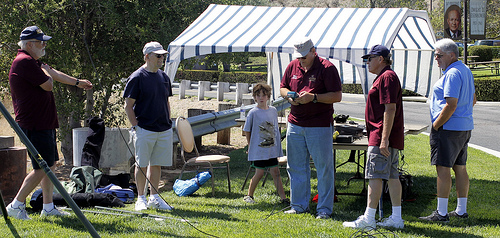Testing a lightweight HF magnetic loop antenna made from 7 metres of RG58 coaxial cable. Contacts were made on 40 and 20 metres during the Lighthouse Weekend. It uses just three main parts: the coax itself, an air-spaced variable capacitor (approx 50 – 100pF max) and a T50-43 ferrite toroid. The toroid is threaded over the coaxial cable. RF from the transceiver is fed via a 2 or 3 turn winding over the toroid (experiment with this for lowest SWR). The coax inner is left unconnected; only the braid is used here. The loop is for low power use only – it will take 10 – 20 watts before the variable capacitor arcs over. Performance is, as expected, somewhere between a smaller pedestrian mobile magnetic loop and a full sized wire antenna. It would be improved if the variable capacitor was a low loss type and the coaxial cable was soldered straight to it. While there’s enough information above to make your own, it’s worth checking out G4FON’s website ( www.g4fon.net ) for similar loops. My loop is closest to his Version 2.
Video Rating: 5 / 5


WOW how cool! i am going to make me one today! Help me with the details?
Great video, Looks like a good bug out antenna
You keep mentioning a “squid” pole. Is it squid, squib, or something else? Also, was the pole designed for some other use, but it just happens to be perfect for holding an antenna, or was it designed to hold antennas in the first place? (Is it used for squid fishing, perhaps?)
Yes it’s a squid pole for catching squid – not that I’ve ever done it.
Great job. Shows you don’t have to be compulsive about the loop construction and tuning cap. Thanks!!!!
p.s. How much power did you use to transmit with this loop? Was there any arcing in the tuning cap?
Interesting … another adaptation of the Edginton (G0CWT Magnetic Loop) loop, another fairly easy to fabricate and tune loop?
More info, search “edginton loop” or on youtube?
.
Nice job. What distances were you getting to other stations?
thx
about 800km for 40m & 2500km for 20m